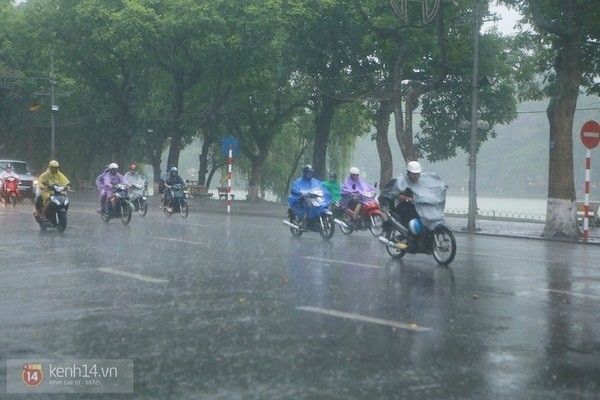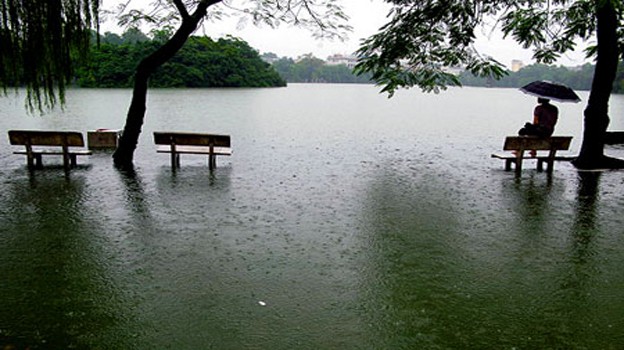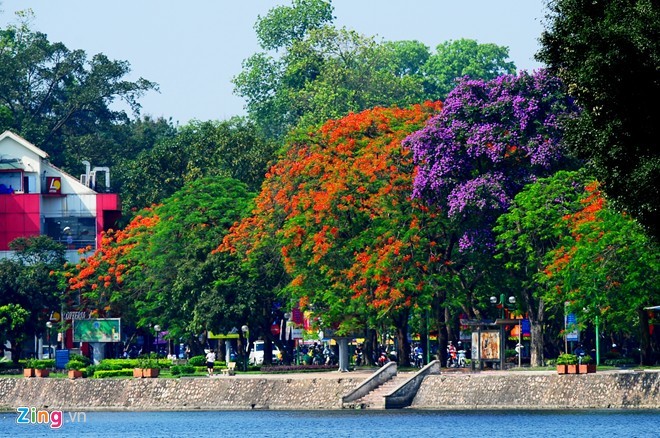(VOVworld) - Northern Vietnam is in the middle of its summer, which is also the rainy season. Here in Hanoi, we are experiencing intervals of extremely hot days and torrential rains.
B: Last weekend it was scorching hot. A heavy rain Monday evening and Tuesday morning ended several blazing hot days. The temperature has dropped from 37 DC to around 30 DC.
 |
| Hanoi street in a summer rain |
A: Due to a wide latitude and varied topography, Vietnam's climate differs greatly from one region to another. Vietnam has two distinct monsoon seasons. The southwest monsoon brings wet, humid weather while the northeast monsoon delivers drizzly, colder temperatures to the north and dry weather to the south.
B: Northern Vietnam has four seasons. During the winter months from December to February, the temperature may dip down to 5DC occasionally, even below zero in the mountains. The summer months of June and July are hot, with daytime temperatures reaching 37°C. Drizzling rains and more tolerable temperatures come in the autumn from August to November, and in the spring from March to April.
 |
A heavy summer rain flooded the street and Hoan Kiem lake
|
A: Vietnam’s central region has warm temperatures all year round, with the hottest months in the middle of the year. The weather from November to April is cooler and drier. The dry season comes to the south from November to April and a wet season from May to October.
B: In summer months from May to August, the capital city Hanoi is very hot with temperatures averaging 32 DC. July is the hottest month when temperatures hover around 38DC. With global warming becoming an increasingly serious problem, summers are hotter with higher humidity.
A: Heavy rain is a feature of Hanoi’s summer. Foreign tourists may be surprised to sweat under a hot sun all day and then get soaked by a thunderstorm in the afternoon or evening. This description of the weather in Vietnam was in response to a question from Indian listener Sanjib Biswas.
 |
| Hanoi in a sunny summer day |
B: Sanjib Biswas used to be a regular listener. But recently he has been busy with his medical studies and this was just his 2nd reception report this year.
A: He wrote: “I’m regular listener to VOV’s English program. The half hour program is nice and informative. The reception is good in Kolkata. News and Current Affairs, the Sunday Show, and the Letter Box are my favorite radio programs.”
B: Thank you very much Biswas for listening to VOV and writing to us. We hope you’ll continue to find VOV a reliable and interesting source of socio-political news and entertainment. We’ll verify your report with a QSL card.
A: We’re very glad to have received an email from Gerry Neumann of England. It included his first reception report since coming back from a recent trip to Vietnam, where he visited the VOV studios and met with members of our English section.
B: He noted that the transmission to Europe on 9625 KHz at 17 UTC still has brief breaks in the broadcast, as it has done since the change of frequency. On July 7th there was a brief fade-out during the domestic news bulletin.
A: Thank you very much, Gerry, for your detailed technical remarks, which help us monitor our foreign broadcasts. We’ll forward your report to our technicians. Once again, thank you for your support for VOV over the past decade. We wish you all the best and we hope to meet you in Vietnam again soon.
B: From West Bengal, India, Ratan Kumar Paul reported listening to VOV from July 1 to 7 at 16:00 to 16:30 UTC on the frequency of 9730 khz. He wrote: “On July 7 in the world news I liked the news about the UK leaving the EU. It was very informative. On that day Current Affairs was about the NATO summit on ways to improve its defense and deterrence capabilities and promote stability outside NATO’s borders.”
A: Ratan wants to know whether Vietnam is a member of SEATO or a similar alliance.
B: Vietnam was never a member of SEATO, the Southeast Asia Treaty Organization, although it was a Southeast Asian alliance for collective defense. It was created by the Southeast Asia Collective Defense Treaty, or Manila Pact, signed in September 1954 in Manila, Philippines. The formal institution of SEATO was established on 19 February 1955 at a meeting of treaty partners in Bangkok, Thailand. The organization's headquarters were in Bangkok. Eight countries joined the organization.
A: Despite its name, SEATO mostly included countries located outside the region but with an interest in the region. The eight members were Australia, France, New Zealand, Pakistan (including East Pakistan, now Bangladesh), the Philippines, Thailand, the UK, and the US.
B: SEATO also funded cultural and educational programs in Southeast Asia. SEATO was dissolved on 30 June 1977 after several members lost interest and withdrew.
A: Vietnam’s military policy is not to join any military alliance, not to allow any country to establish a military base in Vietnam, and not to use or threaten to use force against any other country. Vietnam is a member of several international organizations including the UN, the World Bank, the World Trade Organization, the International Monetary Fund, the Asian Development Bank, the ASEAN Free Trade Area, and the Asia Pacific Economic Cooperation.
B: Our regular listener Richard Nowak from Florida, the US, thanked VOV for sending him a QSL card with an image of the Hoai river in Hoi An province. Richard told us that he enjoyed the show on July 11 on 12005 khz from 1 to 1:27 UTC. He listened with a Realistic DX-160 hooked up to an off center fed dipole antenna with an overall length of 41 meters. Reception was perfect with SINPO rating all 5s.
A: Richard wrote: “The Sunday show was very interesting with a segment on an online virtual museum dedicated to preserving and restoring antiques by using 3D scans. This is the first time I’ve heard of this and found the episode fascinating. Very original and educational show! I will have to check this out online.”
B: We acknowledge a reception report from Anatoly Klepov, Chairman of the Russian DX League. He listened to VOV on July 6 on the frequency of 9625 khz and rated SINPO at 45444.
A: Muralidhar of Bangalore, India, tuned in to VOV’s English program on July 6 on the frequency of 9550 khz. He used a Tecsun PL-660 with a Sangean ANT-60 and rated SINPO all 3s.
B: Thank you all for your support for shortwave. We’ll verify your reception reports and hope you’ll receive our QSL cards soon. Remember that you can listen to us again at anytime on our website vovworld.vn.
A: We welcome your feedback at our station: English Section, Overseas Service, Voice of Vietnam, 45 Ba Trieu Street, Hanoi, Vietnam. Our email address is englishsection@vov.org.vn. Good bye until next time.